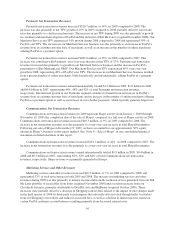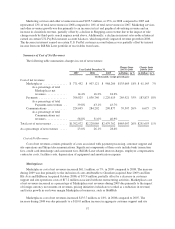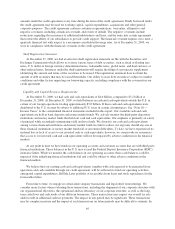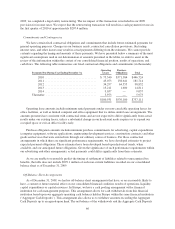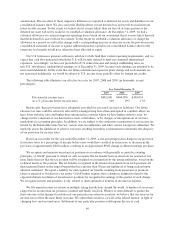eBay 2009 Annual Report Download - page 73
Download and view the complete annual report
Please find page 73 of the 2009 eBay annual report below. You can navigate through the pages in the report by either clicking on the pages listed below, or by using the keyword search tool below to find specific information within the annual report.amounts under the credit agreement at any time during the term of the credit agreement. Funds borrowed under
the credit agreement may be used for working capital, capital expenditures, acquisitions and other general
corporate purposes. The credit agreement contains customary representations, warranties, affirmative and
negative covenants, including a financial covenant, and events of default. The negative covenants include
restrictions regarding the incurrence of additional indebtedness and liens, and the entry into certain agreements
that restrict the ability of our subsidiaries to provide credit support. The financial covenant requires us to meet a
quarterly financial test with respect to a maximum consolidated leverage ratio. As of December 31, 2009, we
were in compliance with the financial covenants in the credit agreement.
Shelf Registration Statement
At December 31, 2009, we had an effective shelf registration statement on file with the Securities and
Exchange Commission which allows us to issue various types of debt securities, such as fixed or floating rate
notes, U.S. dollar or foreign currency denominated notes, redeemable notes, global notes, and dual currency or
other indexed notes. Issuances under the shelf registration will require the filing of a prospectus supplement
identifying the amount and terms of the securities to be issued. The registration statement does not limit the
amount of debt securities that may be issued thereunder. Our ability to issue debt securities is subject to market
conditions and other factors impacting our borrowing capacity, including compliance with the covenants in our
credit agreement.
Liquidity and Capital Resource Requirements
At December 31, 2009, we had cash and cash equivalents of $4.0 billion, compared to $3.2 billion at
December 31, 2008. At December 31, 2009, we held balances in cash and cash equivalents outside the U.S. in
certain of our foreign operations totaling approximately $3.0 billion. If these cash and cash equivalents were
distributed to the U.S. we may be subject to additional U.S. taxes in certain circumstances. See “Note 18 —
Income Taxes” to the consolidated financial statements included in this report. Our available cash and cash
equivalents are held in bank deposits and money market funds. We actively monitor the third-party depository
institutions and money market funds that hold our cash and cash equivalents. Our emphasis is primarily on safety
of principal while secondarily maximizing yield on those funds. We diversify our cash and cash equivalents
among various financial institutions and money market funds in order to reduce our exposure should any one of
these financial institutions or money market funds fail or encounter difficulties. To date, we have experienced no
material loss or lack of access to our invested cash or cash equivalents; however, we can provide no assurances
that access to our invested cash and cash equivalents will not be impacted by adverse conditions in the financial
markets.
At any point in time we have funds in our operating accounts and customer accounts that are with third party
financial institutions. These balances in the U.S. may exceed the Federal Deposit Insurance Corporation (FDIC)
insurance limits. While we monitor the cash balances in our operating accounts, these cash balances could be
impacted if the underlying financial institutions fail and could be subject to other adverse conditions in the
financial markets.
We believe that our existing cash and cash equivalents, together with cash expected to be generated from
operations and cash available through our credit agreement, will be sufficient to fund our operating activities,
anticipated capital expenditures, Bill Me Later portfolio of receivables from loans and stock repurchases for the
foreseeable future.
From time to time, we engage in certain intercompany transactions and legal entity restructurings. We
consider many factors when evaluating these transactions, including the alignment of our corporate structure with
our organizational objectives, the operational and tax efficiency of our corporate structure, as well as the long-
term cash flows and cash needs of our different businesses. These transactions may impact our overall tax rate
and/or result in additional cash tax payments. The impact in any period may be significant. These transactions
may be complex in nature and the impact of such transactions on future periods may be difficult to estimate. In
65



